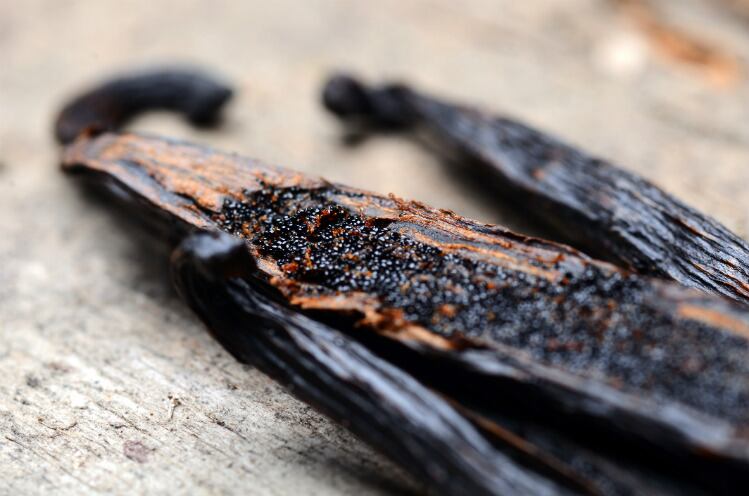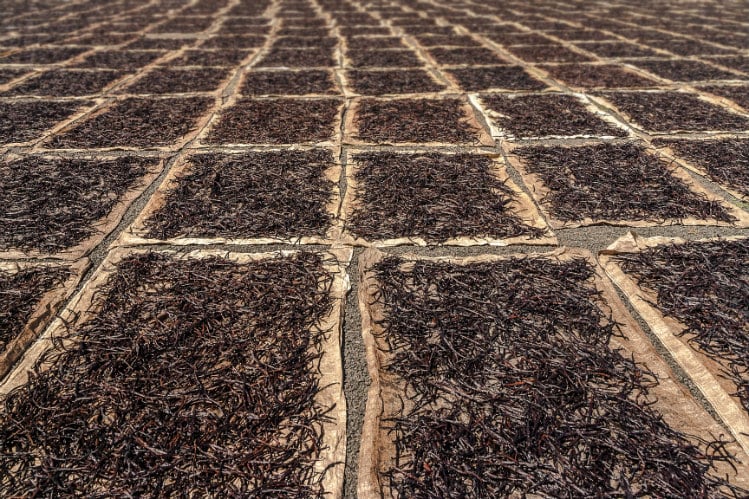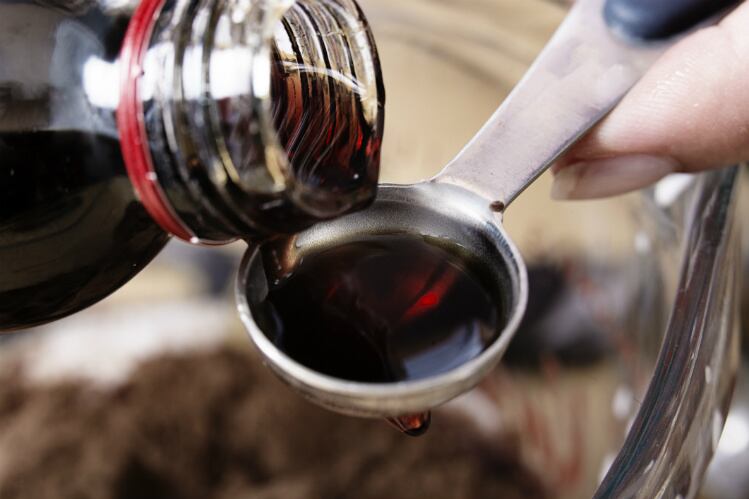Derived from the fermentation of ferulic acid found in rice bran oil, Solvay tells us that food manufacturers can substitute its Rhovanil ingredient for synthetic vanilla or real vanilla extract drop-for-drop. Approved by the FDA and the EU, as well as being halal and kosher, Solvay’s natural vanillin satisfies clean-label demands: it can be labeled as ‘natural vanillin, ‘vanillin’ or ‘natural flavor.’
In fact, the FDA has certified only Rhovanil as ‘natural vanillin’ since changing its rules in 2007. That decision declared that the once-common vanillin derived from lignin or eugenol (an oil found in clove, nutmeg, cinnamon, basil and bay leaf) must be labeled as artificial. Today, most artificial vanillins start from guaiacol or lignin, compounds found in wood.
Solvay introduced its natural vanillin to the US market at last year’s IFT show, but the continued evolution of contemporary tastes compelled the Brussels-based company to highlight the product again.
“Honestly, we cannot keep up with the demand because the feedback is so positive,” said Lucy Simek, executive VP and general manager for the Americas at Solvay Aroma Performance. “It is one of those products where we’re following and meeting the needs of the market – which is the natural labeling, the natural trend.”
“We’ve been making vanillin for 130 years, so it is absolutely something that we’re very passionate and knowledgeable about,” she continued. “It makes sense for us to extend the product line and to adapt to the markets and the needs and the trends that are happening.”
Trial and application
To be considered natural, an ingredient must...
In the EU:
- be sourced from a raw material found in nature
- undergo a natural biological process, such as fermentation
- represent a molecule that occurs naturally, as does vanillin
In the US:
- be sourced from plant or animal matter
- undergo a natural process, such as heated or fermented
- function solely as flavor, not nutrition
According to Solvay, Rhovanil offers a vanilla flavor that is more true to the original than synthetic and, it says, than other natural alternatives.
“There is no off note, no variations in the profile – it is very pure,” Corinne Duffy, technical marketing manager at Solvay Aroma Performance, told us. Other natural vanillins yield a “different taste which is sometimes not typical of vanillin.” Rhovanil strives to offer the industry a ‘standardized’ taste that works across applications.
According to Duffy, Solvay has fleshed out two distinct profiles of vanilla extract desired by the US market: a ‘more rummy, bourbon type with a strong profile’ and a ‘more sweet, creamy type.’
“We are really trying to look at the local taste. For example, we know that white chocolate is not such a big product in the US versus, for example, France or Europe, and we are really trying to look at specificities for the various applications according to the regions,” she said.
Chocolate and confectionery producers most often approach Solvay for a natural answer to synthetic vanillin – the company’s ‘historical market.’ The US market tends to seek a ‘typical vanilla taste’ in higher dosages than elsewhere in the world, where over-the-top sweetness is less desired.
Solvay’s international Rhovanil does not differ greatly in taste from the US version, Duffy said, but noted that the company makes both ‘purely because of legislation.’

The company develops and tests its vanillins in three Vanil’Expert Expert Center (Vec): in Saint-Fons, France; Zhenjiang, China; and Princeton, New Jersey.As another antidote to vanilla bean extract, Solvay also offers a line of ‘vanilla solutions’ called Vanifolia that “reconstruct the taste of vanilla extract with other flavoring substances,” according to Duffy. These five products – three of which can be labeled as ‘natural vanilla flavor’ rather than simply ‘natural flavor’ – offer a range of flavor profiles ideal for particular applications. The priciest variant carries ‘intense bourbon vanilla taste with beany and fruity facets,’ for example: Solvay recommends a dosage of 0.5% to 0.1% in milk and white chocolate, up to 0.2% in ice cream and up to 0.25% in cakes and muffins.
Basically the experts tell us: the vanilla crisis is not going to soften. Prices are going to remain high. Now we see in the market that high-end food products – ice creams or gourmet foods – can’t afford a vanilla extract or vanilla derivatives.
Corinne Duffy, Solvay Aroma Performance
The natural wave: a result of clean and cost
The vanilla industry has suffered at the hands of an inhospitable climate rife with natural disasters as well as troubled political systems. Complicating matters, the beans can only grow within 10 to 20 degrees of the equator.
Nielsen-Massey, an Illinois-based producer of vanilla and other flavor extracts, reported in its first-ever crop sustainability report that Madagascar, Indonesia and Papua New Guinea produced more than 90% of the world’s vanilla beans in 2018; Madagascar alone accounts for 75% of that supply. Uganda, Indonesia, India, Mexico and Tahiti also grow the crop.
The century-old company eyes a potential upside to rising costs, however, as other countries have begun invested in the coveted flavor.
- Hawaii boasts the only commercial vanilla farm in the US, while the Cook Islands have also invested in exports.
- Researchers at the University of Florida have embarked on a project to understand the viability of growing vanilla in the continental US. According to Nielsen-Massey, four species are native to the US but are endangered due to habitat loss or illegal collection.
- Tanzania has caught on to Uganda’s success with the plant, with support from private investment.
- With a similar climate to Madagascar, the island of Comoros also grows vanilla. Recent support from the UN helped form a National Office of Vanilla to spur industry expansion.
- The government in Somoa – notably the prime minister – have taken steps to nurture a vanilla industry, going so far as to provide agricultural loans to establish farms.
“Vanilla pods have a limited supply, and the market demand is still growing for natural flavors,” explained Duffy. “You know that there is a vanilla crisis because the prices have surged to about $500 per kilogram in recent years, and basically the experts tell us: the vanilla crisis is not going to soften. Prices are going to remain high. Now we see in the market that high-end food products – ice creams or gourmet foods – can’t afford a vanilla extract or vanilla derivatives.”

Meanwhile, she added, “mainstream food products and food companies are looking at alternatives for vanilla extract” that meet clean-label expectations.
Duffy emphasized that ‘there is nothing wrong’ with synthetic vanillin from a health perspective. More often than not, consumers are getting their vanillin fix in chocolates or sweet baked goods. “This is an indulgence product,” she said, “so in terms of marketing, it makes more sense to work on the natural flavors.”
But the choice comes at a cost: Duffy estimated that manufacturers pay three to five times more Vanifolio’s vanilla solutions and five to six times more for Rhovanil’s natural vanillin.
“Let’s not forget that the vanilla bean only contains 1% of vanillin,” she added, referring to the tangible amount of extract in a single vanilla bean. “So if you do the math, the price per kilogram is more like tens of thousands of dollars. So really, it’s huge.”
The price point has not deterred manufacturers who “know they are going to have to pay more” for that natural claim.
“We see quite often customers reformulate several things, because they decided to reduce the sugar, [or] they decided to put some other ingredients in it for a lot of reasons,” continued Duffy. “They end up reworking the base, so all in all, that changes the cost and the profile a little bit.”

